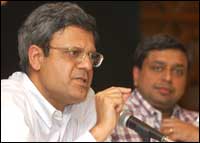 While stating he would probably have to follow rival Coke, once again, if it went in for Rs 4 pricing, Pepsi's India head Rajiv Bakshi says FMCG firms have to focus on premium pricing to be able to grow at 20-25 per cent a year.
While stating he would probably have to follow rival Coke, once again, if it went in for Rs 4 pricing, Pepsi's India head Rajiv Bakshi says FMCG firms have to focus on premium pricing to be able to grow at 20-25 per cent a year.
He tells Business Standard, the market's never been so right before. Excerpts:
You've been saying the old price-penetration model isn't going to give you the kind of growth you need. So, was the old paradigm wrong?
It wasn't wrong, but it delivered, and can deliver, only single-digit growth, or at most growth in the low teens. Today, with an 8 per cent GDP growth, you've got huge growth in the number of families in the upper income segment, I think the number of car-owning households (10 million households and 50 million people in them) is the best way to look at this.
These people can now afford to buy more expensive drinks. Gatorade, Diet Pepsi, Tropicana, Cafe Chino. . . they're all targetted at this group. If I want a 20-25 per cent topline growth, I can no longer use the old one-size-fits-all pricing strategy.
In the 1990s, most FMCG companies focused on value pricing. There was no room to do more. But in this decade, say, in 2001-02, FMCG companies should have developed premium categories.
Two to three years ago, we started seeing a boom in the car market -- the B segment started selling more than the Maruti 800, Mercedes became a Rs 1,000-crore (Rs 10 billion) brand selling cars at around Rs 40 lakh (Rs 4 million) apiece. All this points to a dramatic hike in the purchasing power of the creamy layer...
I think FMCG firms need to develop a business model of premium pricing in what I'd call the mass-luxury segment. The reason why this couldn't be done earlier is that you didn't have mass in this market. Today, you have the mass. Today, the growth in the upper income classes is faster than in the lower income ones -- that's the difference that FMCG companies need to react to. It would be difficult to find a Tropicana drinker in your family 10 years ago, today it's a different matter.
Do the numbers add up? If you want a 20-25 per cent growth, you need around Rs 600-700 crore (Rs 6-7 billion) from these 'mass-luxury' brands like Tropicana, Gatorade, Cafe Chino. Right now, they're around Rs 100 crore (Rs 1 billion) for Tropicana and next-to-nothing for the others.
They do. I said half my growth would come from this segment, and I can easily get Rs 250-300 crore (Rs 2.5-3 billion) of sales from this segment.
So it's goodbye to the Chhota Pepsi? And you'll no longer do the CK Prahlad bottom-of-the-pyramid strategy for rural areas?
I was a follower in the Rs 5 strategy. The issue's not either/or. You have to be in rural markets as well. All that I'm saying is that merely following a bottom-of-the-pyramid strategy won't give you anything more than a single-digit growth, or the low teens. What I'm saying is that you need to do penetration-pricing as well while offering premium-pricing simultaneously, essentially a multi-layered strategy. So far, FMCG companies have not tried to stratify the market. That's all.
If Coke did a Rs 4 bottle, would you follow?
I'd have to.
Even if you lost money doing this? I understand you lost Rs 250 crore (Rs 2.50 billion) on the low-pricing strategy.
That number is not correct.
How much did you lose?
I can't give you a number, or even whether I lost money or made money.
Are rural markets worth it? Is the return as high as it is in the urban ones, especially since your 'mass-luxury' sales are primarily in urban areas?
Rural markets have higher distribution costs but lower discounting, so the margins are probably the same as urban areas. The point I'm making is that in rural markets, the amount you can sell is limited by the surplus available with families. So they are important, but cannot give high growth.
Didn't the Rs 5 bottle drive volumes? If it gets people to drink more Pepsi, what's the problem?
Consumption behaviour isn't that dependent upon prices. It has to do with income, with ambience. You pay Rs 7-8 per bottle of Pepsi on the road but Rs 25 in a multiplex, you pay Rs 20 for a can of Diet Pepsi, Rs 12 for a non-returnable glass bottle of Diet Pepsi. So, once people get into a multiplex, they consume more (just 5 per cent of those going to the traditional cinemas bought cold drinks versus 70 per cent in multiplexes) and they pay more.
Basically, there's enough data to show that as incomes rise, people spend more on cold drinks, whether they're carbonated or non-carbonated doesn't matter.
The elasticity you're looking for is not related to price, but to GDP, and the multiple is three. The trickle-down effect of economic growth is happening. So, let's say, the economy's growing at 5.5 per cent and Pepsi sales are growing at 12 per cent.
Now, if the economy grows at 8 per cent, Pepsi's growth is now 12 per cent plus 2.5 (the incremental GDP growth) into 3, or 19.5 per cent. And that happens because the GDP growth is accompanied by a sharper rise in the number of rich families which have more disposable income to spend on, say, cold drinks. This multiplier of three is not a hypothesis, it is tested with real figures for economic growth and Pepsi sales.






